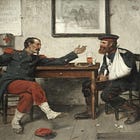
Between 1943 and 1945, Chrysler Corporation built 1,837 copies of the SCR-584 radio set. Optimized to find targets for 90mm anti-aircraft guns, many of these ended up in anti-aircraft battalions armed with the towed version of the latter weapon.1
These radar sets reported for duty at a time when the danger posed by German aircraft to American ground forces had diminished considerably. Thus, by the end of 1944, the US Army had disbanded many of its anti-aircraft battalions. Those that remained, and the radar sets with which they were equipped, found themselves, as folks would later say on Linked In, ‘open to new opportunities’.
In April of 1944, anticipation of this happy turn of events led the War Department to assign anti-aircraft battalions the secondary duty of reinforcing the fires of the field artillery and, in keeping with that mission, mandated instruction in the art of indirect fire. In doing this, however, it provided no guidance on the role that radar - which had been allocated at a rate of five sets per battalion - might play in that mode of employment.
In keeping with this policy, the 45th Infantry Division prepared for an offensive north of the Anzio beachhead by calling on the services of four battalions of anti-aircraft guns. However, while the first day of this operation (23 May 1944) saw the forty-eight 90mm guns of these battalions fire a total of 3,500 rounds, the twenty radar sets at the disposal of those units played no role in the operation.2
A few weeks afterwards, in Normandy, a single anti-aircraft gun battalion reinforced the fires of the field artillery of one of the divisions of VIII Corps. While doing this, the battalion occupied two locations, a forward position for the 90mm guns serving as field pieces and, much further to the rear, a site better-suited to its primary purpose. Serving in the latter locale, the radar operators began to experiment with the use of the SCR-584 to locate hostile batteries.3
For Further Reading
Wesley W. Stout The Great Detective (Detroit: Chrysler Corporation, 1947) page 52
‘Review of 90mm Ground Fire Support in Anzio Offensive’ Headquarters Antiaircraft Command Antiaircraft Information Bulletin (20 October 1944) (Combined Arms Research Library)
‘Immediate Report Number 13 (Combat Observations), 28 July 1944’ Immediate Reports of Combat Observations 130 to 1 Combined Arms Research Library






I can’t open footnote 2; did they track any incoming shells on radar?
Fascinating stuff. The SCR 584 somehow managed to be an air search and tracking air defense radar; a battery and counter-battery radar; a moving target indicator radar and later a middle tracking and weather radar? And I think the Army also used the dish for the Rawinsonde Artillery Weather system. Wow.